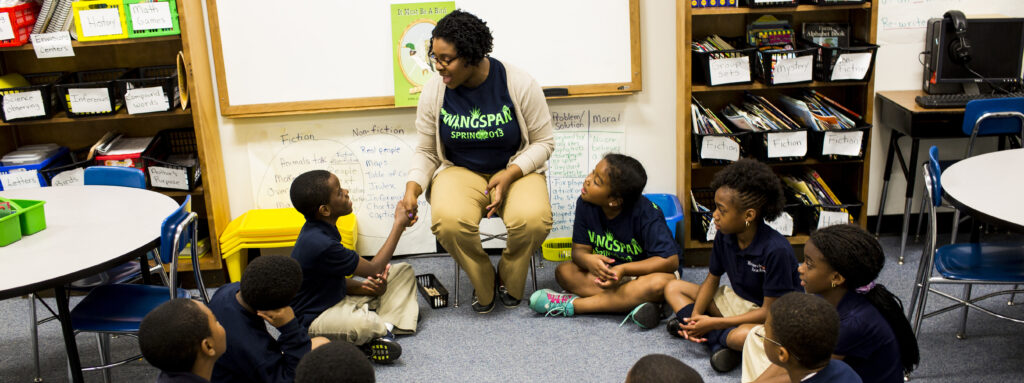Sharif El-Mekki, the Founder and Chief Executive Officer of the Center for Black Educator Development, knows firsthand the impact that regular exposure to positive Black role models can have on students—especially young Black boys.
His parents were both activists in the Black Panther Party. Before he attended middle schools in Iran and high school in Philadelphia, he attended the Nidhamu Sasa African Freedom School, where he met Baba Changa.
“Baba Changa was my martial arts, geography and history teacher, and he had a huge influence on me,” El-Mekki says. “Right up until his death just a few years ago, I loved him like a father.”
As a young Black boy, it was teachers like Baba Changa who undoubtedly helped El-Mekki thrive. Unfortunately, most students of color today aren’t afforded the same experience.
While a majority of our nation’s public school students identify as people of color, fewer than 20% of teachers are people of color—and only 2% are Black men. Forty percent of all public schools don’t have a single teacher of color. This is despite evidence that a diverse workforce of talented teachers is good for all children, schools, and communities.
“When you have a lack of diversity, that means you have a lack of diverse experience and cultural backgrounds,” El-Mekki explains. “And it doesn’t stop there. Lack of diversity also impacts the ecosystem of education. Not having diverse teachers ensures that one group, a white dominant culture, will continue to overly impact the system that students are learning in, which will not set them up for success.”
For Black students, having even one Black teacher can make a huge difference.
“When students have teachers who reflect the world they want to be a part of, they do better” El-Mekki explains. “White students typically have mirrors in front of them leading the classroom and that reinforces their identity, their goals, their aspirations. Students of color often don’t have these mirrors, they have windows.”
Yet for most schools, recruiting and retaining Black teachers is the epitome of struggle. That’s largely because of barriers that keep talented prospective teachers out of the classroom and push them out of the profession, such as cost, inequitable certification rules, and one that is dear to El-Mekki’s heart: school cultures.
“Teachers of color often leave their schools because of three main reasons: relationships with their supervisors, how they’re treated by so-called colleagues, or the working conditions,” El-Mekki says. “But if the schools and the districts aren’t looking at these types of patterns and understanding them, then it’s willful negligence on their part, which further perpetuates a problem and will impact a teacher’s desire to stay in this profession.”
In other words, increasing teacher diversity isn’t just about successfully hiring more teachers of color; it’s about keeping them, too.
“The best recruitment strategy is a robust, comprehensive, and thoughtful retention strategy,” says El-Mekki. “If students of color and undergraduates see highly effective teachers of color in an environment where they are happy and thriving, feel respected, valued and have leadership roles in their schools and districts, it’s more likely that more teachers will come and stay.”
But how does a school create that kind of environment? El-Mekki has a few ideas, starting first with acknowledging race.
“For too long there have been too many school and district leaders who would say, ‘I don’t see color,’ which ultimately erases the experiences of educators of color,” the former principal says. “This can’t be a part of any comprehensive plan to improve a school or a district. You can’t address diversity and retention issues if you don’t talk about race, power, class, and privilege.”
And it doesn’t stop there. Sharif says schools also have to take a hard look at their culture and how they show up for the people they serve.
“How, schools interact and serve the community they’re a part of matters,” he explains. “Whether it’s a teacher, student, or grandmother, people of color will recognize how they are valued from the moment they step in the door.”
That’s why it is necessary to create school environments that are culturally affirming not only for teachers, but for students, too. How teachers see students of color experiencing school makes a difference. By creating a space where teachers of color can be their authentic selves, schools also create an environment that allows teachers of color to show up for their students like never before. It’s something that El-Mekki says can only happen after you have the right foundation.
“You can’t add equity window dressings to a building that has a foundation of racism. You have to start at the foundational level and rebuild and re-imagine our schools so that they truly serve communities of color,” he says. “That’s why as a leader, it’s really important for your school culture to be student and community facing. If it’s not, then it can be oppressive.”
Ultimately, schools seeking to do what is best not only for students of color, but for all students, must be willing to do better by teachers of color. It’s not good enough to simply get teachers of color in the door. School leaders must be intentional about listening to teachers of color and make engaging with them an ongoing practice if they’re serious about retaining them. That means cultivating a culture that will make teachers of color want to stay—one that affirms them, creates a support system, and invests in them both inside and outside the classroom. We won’t get the diverse teacher workforce our students need until more schools start truly valuing teachers of color—by acknowledging and addressing the unique challenges they face every day.
* Sharif El-Mekki is the newest member of TNTP’s Board of Directors.








